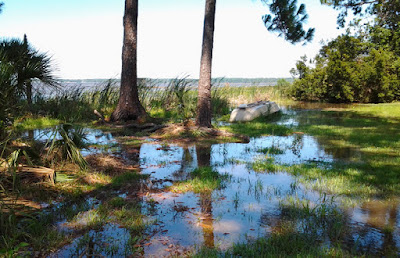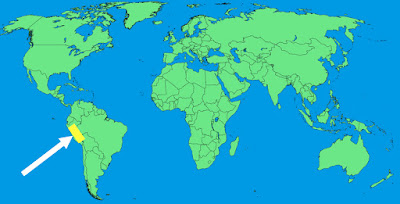Let’s start with a comment never heard from in theorists’ writing, though it is quite important, and begins our discussion with the elimination of every other place on Earth as the Land of Promise other than Andean Peru. It is found in Alma, and a simple, but straight-forward comment ignored by everyone else because it does not relate to anywhere else but the true Land of Promise.
It is a well understood fact that standing
water draws mosquitoes, the precursor to fevers, particularly deadly fevers
Mormon mentions that “There were some who died with fevers, which at some seasons of the year were very frequent in the land—but not so much so with fevers, because of the excellent qualities of the many plants and roots which God had prepared to remove the cause of diseases, to which men were subject by the nature of the climate” (Alma 46:40).
The most dangerous type of killer fever was
malaria in ancient Rome and played a key part in the downfall of the Empire. Ancient
writers called it a zone of pestilence and people died of the fevers, and
modern research indicates that the most serious type of malaria (plasmodium falciparum) ravished Rome and
much of the ancient world
Even so, and despite all the research and the synthetics now available from quinine, and though malaria researchers have won multiple Nobel Prizes for their achievements, the disease continues to afflict some 200 million patients each year, killing more than 600,000 because certain countries have failed to take the necessary precautions of eliminating the mosquitoes and their habitats of standing water, swamps, and marshes in areas like Africa and other Third World Countries.
One
hundred officers commanded malaria control units stateside and overseas during
World War II, where it is claimed more soldiers died from malaria than combat
when quinine supplies ran out
Throughout history, malaria has been a serious scourge on the world’s population. Fevers causing death, or malaria, did not have a name anciently, but was the greatest fever malady the world has ever known. It was a plague on ancient civilizations from the beginning of time. In fact, we live on a malarious planet and even today, with all our advanced technology, malaria is still endemic to 106 countries, threatening half the world’s population. It is figured that this year malaria will strike half a billion people, and at least a million will die—and that is with the knowledge of mosquitoes, malaria controlling drugs and techniques known today. In the time of the Nephites, malaria was known simply as a fever that killed—the word malaria being coined much later in time from an Italian word mal’aria meaning “bad air.”
However, fevers date back about 40 centuries. These killer fevers were well documented by the Chinese and Greeks, and even the father of medicine, Hippocrates. Not until the 17th century A.D. was quinine discovered generally, though the Andean natives had been using it for over two thousand years. It was found in the medicinal bark of the Chinchona tree, which was indigenous only to the Peruvian Andes. There, the bark had been used to not only successfully combat the fever of malaria, but a host of other diseases and maladies.
Nowhere else on the planet was found the cinchona tree, its medicinal bark, and quinine—the only cure for malaria fevers that has ever been discovered until the 19th century when the Dutch stole starts from the Andes and planted the cinchona tree in what is now Indonesia. Only in this Andean area of Ecuador, Peru and Bolivia did quinine exist anciently and naturally, a root and plant that fought both fevers and other “diseases to which men were subject by the nature of the climate.”
Left and Top Right: Cinchona pubescens or Quina is a genus
of about 8 species in the family Rubiaceae, native to the tropical Andes
forests of western South America; Bottom Right: The bark of this genus is the
source of a variety of alkaloids, the most familiar of which is quinine, an
anti-fever agent especially useful in treating malaria, and are known as
medicinal plants
In addition, because the Nephites used the quinine producing bark of the cinchona tree, the Spanish became familiar with it and ended up transporting it back to Europe where it eventually was the sole cause of so many lives saved from malaria through Europe and Asia.
It is always interesting to see how the Lord prepares in advanced and arranges for events of one area or time to benefit those of another place or time. Consider the Jaredites bringing honey and seeds into the seashore area where they built their barges and left for the Land of Promise—centuries later the area was a veritable Bountiful full of fruit and honey as Nephi describes it “and all these things were prepared of the Lord that we might not perish” (1 Nephi 17:5). Or the animals the Jaredites brought to the Land of Promise after the Flood killed off every living thing, and through the plague of the poisonous snakes, drove animals into the Land Southward that by the time the Nephites arrived, Nephi said: “we did find upon the land of promise, as we journeyed in the wilderness, that there were beasts in the forests of every kind, both the cow and the ox, and the ass and the horse, and the goat and the wild goat, and all manner of wild animals, which were for the use of men” (1 Nephi 18:25). Or the crops the Pioneers planted along the way that grew to benefit the next pioneer group that passed that way.
In the case of the fevers, knowing how men would fall prey to such disease, a cure was arranged for and few died: “because of the excellent qualities of the many plants and roots which God had prepared to remove the cause of diseases, to which men were subject by the nature of the climate” (Alma 46:40).
There was only one place in the entire world prior to the 1800s A.D. where cinchona tees and quinine to cure killing malaria fevers could be found (Map of the world from mapofworld.com)
(See the next post, “Finding Lehi’s Isle of Promise – Part XIII,” for Mormon’s description of the buildings and their purposes found all over the Land of Promise)









Once again, you make a very valid point that anyone who did not have an agenda should accept as at least an evidence for this model. But instead, the response will be "the silence", punctuated from time to time with how absurd the Andes model is so do not even consider it.
ReplyDeleteExactly!
ReplyDelete